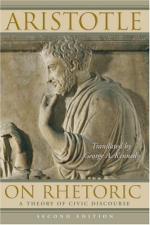
|
| Name: _________________________ | Period: ___________________ |
This test consists of 5 multiple choice questions, 5 short answer questions, and 10 short essay questions.
Multiple Choice Questions
1. What did Aristotle think was wrong with the metaphor that compared a man with a square?
(a) He thought it was too complex.
(b) He thought it was too simple.
(c) He thought it was confusing.
(d) He thought it was boring.
2. How many general forms of enthymemes were discussed by Aristotle in Book II, Chapter 23?
(a) Twenty eight.
(b) Thirty four.
(c) Thirty eight.
(d) Twenty four.
3. What was Aristotle's opinion about using compound words in a speech?
(a) They should generally be used.
(b) Most were acceptable if they were used correctly.
(c) They should generally be avoided.
(d) Some were acceptable if they were used correctly.
4. Based on Aristotle's explanation of the wealthy, how did wealthy people view the opinions of others about money?
(a) They thought that most people understood their view of money, but did not understand the reasons for it.
(b) They thought that everyone shared their view of money.
(c) They thought that most people were incapable of understanding their view of money.
(d) They thought that everyone disagreed with their view of money.
5. How many periods of a lifetime did Aristotle discuss in Book II, Chapter 12?
(a) Four.
(b) Five.
(c) Three.
(d) Two.
Short Answer Questions
1. Why did Aristotle say that amplification and depreciation were not forms of enthymemes?
2. Using an example of the similarities or differences between parents and their children, how did Aristotle describe Socrates' children?
3. Why did Aristotle consider metaphors to be useful in Book III, Chapter 10?
4. In Aristotle's opinion, why were many people not swayed by sound arguments?
5. As discussed in Book III, Chapter 12, what should legal rhetoric blend argumentation with?
Short Essay Questions
1. Which example did Aristotle use to display the fallacious ways an enthymeme could be formed?
2. Based on the information in Book III, Chapter 10, which ideas could a metaphor help to deliver and why?
3. How did Aristotle compare a simile and a metaphor in Book III, Chapter 4?
4. How did Aristotle explain the different kinds of arguments used by the three types of rhetoric in Book II, Chapter 18?
5. What were the four ways that Aristotle listed about how objections could be raised?
6. What were some of the characteristics of a refutative enthymeme?
7. Which rules for poetry and prose did Aristotle outline in Book III, Chapter 2?
8. As the second type of example, what were the two forms of the invented facts?
9. Which styles of political, forensic, and epideictic rhetoric were discussed at the end of Book III, Chapter 12?
10. What were some of the ways Aristotle described what was and was not possible in rhetoric and oratory?
|
This section contains 898 words (approx. 3 pages at 300 words per page) |

|




